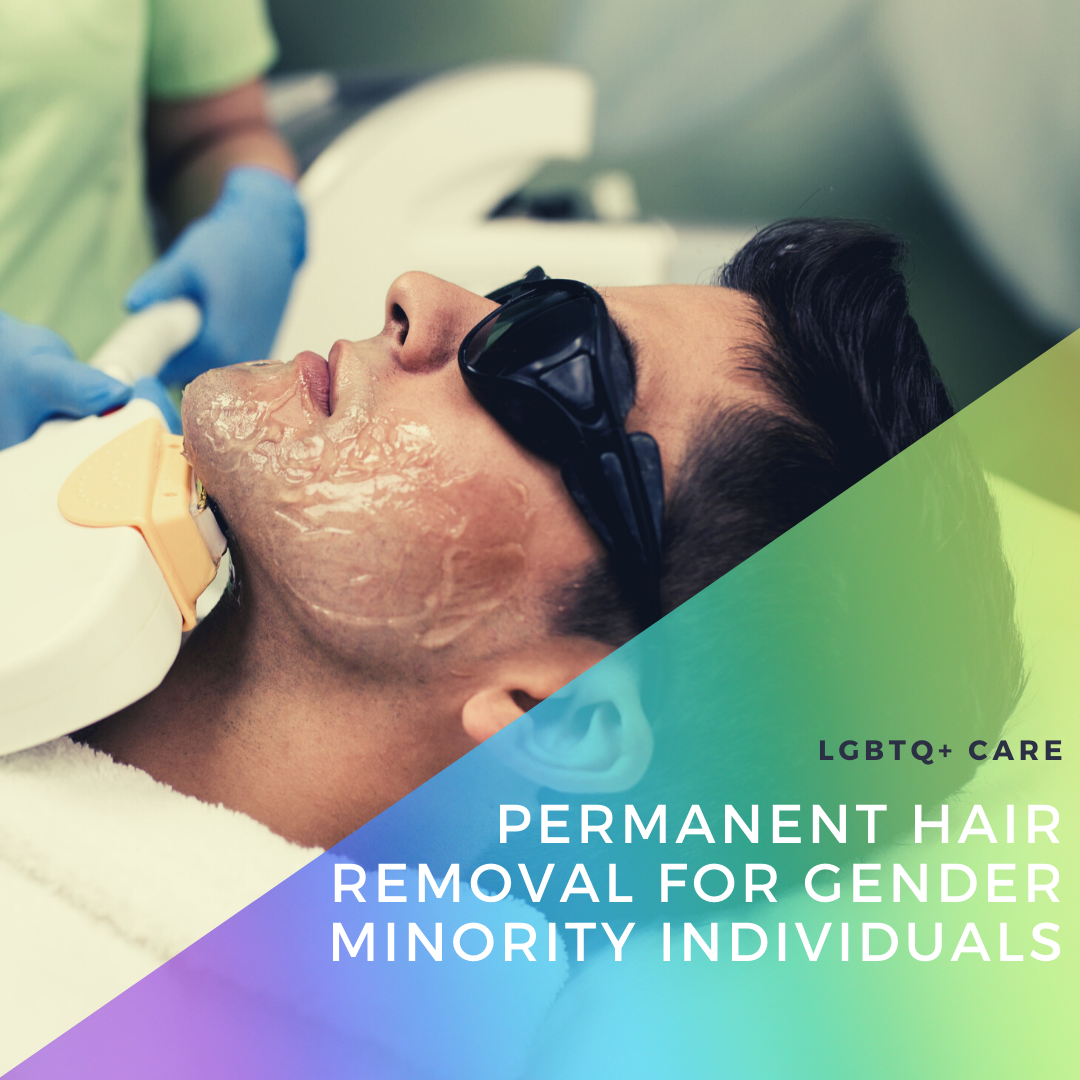What are the unique indications for permanent hair removal in gender minorities?
For transgender women and other gender minority people seeking a more feminine and/or androgynous appearance, the use of feminizing hormone therapy (e.g. estrogen + finasteride/spironolactone) does not fully eliminate facial and body hair.1 Many transwomen indicate the face as the most important body part for gender affirmation, with facial hair being especially stigmatizing. Permanent hair removal, such as electrolysis and laser hair removal (LHR), can thus be utilized in addition to feminizing hormone therapy to help gender minority individuals to achieve their desired appearance.2
An additional critical indication for permanent hair removal in gender minorities is preoperative preparation for certain gender-affirming surgeries (i.e. vaginoplasty, phalloplasty), which involve the use of hair-bearing flaps. If hair removal is not performed prior to surgery on both the donor and genital sites, subsequent intraurethral and/or intravaginal hair may result and lead to discomfort, obstruction, and infection.3
Should I recommend laser hair removal or electrolysis?
Currently, there are no head-to-head trials comparing the efficacy of LHR to electrolysis in gender minority people. Given the limited evidence, individual preference and Fitzpatrick type should guide hair removal recommendations.4 LHR offers the benefit of treating a larger body surface area in fewer and shorter sessions. However, it may be less effective in patients with darker skin tones and cannot treat lighter, vellus hairs. In comparison, electrolysis involves numerous, lengthy treatment sessions but allows for greater versatility in respect to patient skin and hair type.5
Is permanent hair removal covered by medical insurance for gender minorities?
The position statement set forth by the World Professional Association for Transgender Health (WPATH) declares facial and preoperative hair removal as medically necessary gender-affirming procedures.6 Despite this, there remains wide state-by-state variability in health policies and medical coverage regarding gender-affirming care in general and hair removal specifically. Even in states with more inclusive gender minority health policies, LHR and electrolysis are infrequently covered. In a recent survey study of 991 gender minority people in the United States, only 3% of respondents with medical insurance indicated that their insurance provider covered the full cost of hair removal for both pre-operative and other indications.1
How else can I help reduce out of pocket costs for patients?
In general, costs associated with gender-affirming procedures are considered to be tax-deductible under the United States Tax Court’s ruling in O’Donnabhain v Comissioner (2010).7 While the ruling did not specifically discuss hair removal, LHR and electrolysis for gender affirmation may be considered deductible expenses. Additionally, patients may use flexible spending accounts and health savings plans to cover associated costs.
References
-
- Marks DH, Hagigeorges D, Manatis‐Lornell AJ, Dommasch E, Senna MM. Excess hair, hair removal methods, and barriers to care in gender minority patients: A survey study. J Cosmet Dermatol. September 2019:jocd.13164. doi:10.1111/jocd.13164
- Ginsberg BA, Calderon M, Seminara NM, Day D. A potential role for the dermatologist in the physical transformation of transgender people: A survey of attitudes and practices within the transgender community. J Am Acad Dermatol. 2016;74(2):303-308. doi:10.1016/j.jaad.2015.10.013
- Gao Y, Maurer T, Mirmirani P. Understanding and Addressing Hair Disorders in Transgender Individuals. Am J Clin Dermatol. 2018;19(4):517-527. doi:10.1007/s40257-018-0343-z
- Marks DH, Peebles JK, Dommasch E. Hair Reduction for Transgender Persons: What Dermatologists Should Know and How They Can Help. JAMA Dermatol. April 2019. doi:10.1001/jamadermatol.2019.0149
- Fernandez AA, França K, Chacon AH, Nouri K. From flint razors to lasers: a timeline of hair removal methods. J Cosmet Dermatol. 2013;12(2):153-162. doi:10.1111/jocd.12021
- Position Statement on Medical Necessity of Treatment, Sex Reassignment, and Insurance Coverage in the U.S.A. December 2016. https://www.wpath.org/media/cms/Documents/Web%20Transfer/Policies/WPATH-Position-on-Medical-Necessity-12-21-2016.pdf.
- RHIANNON G. O’DONNABHAIN, Petitioner, v. COMMISSIONER OF INTERNAL REVENUE, Respondent. United States Tax Court.; 2011. https://www.irs.gov/pub/irs-aod/aod201103.pdf.
Did you enjoy this article? Find more on LGBTQ+Care here.


